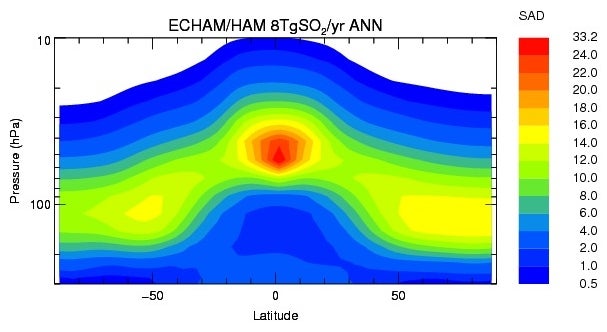GeoMIP G4-Specified Stratospheric Aerosol Data Set
Reference:
Tilmes, S., Mills, M. J., Niemeier, U., Schmidt, H., Robock, A., Kravitz, B., Lamarque, J.-F., Pitari, G., and English, J. M.: A new Geoengineering Model Intercomparison Project (GeoMIP) experiment designed for climate and chemistry models, Geosci. Model Dev., 8, 43-49, doi:10.5194/gmd-8-43-2015, 2015.
Motivation:
A new Geoengineering Model Intercomparison Project (GeoMIP) experiment "G4 specified stratospheric aerosols'' (short name: G4SSA) is proposed to investigate the impact of stratospheric aerosol geoengineering on atmospheric composition, climate, and the environment. In contrast to the earlier G4 GeoMIP experiment, which requires an emission of SO2 into the model, a prescribed aerosol forcing file is provided to the community, to be consistently applied to future model experiments between 2020 and 2100. This stratospheric aerosol distribution, with a total burden of about 2 Tg S has been derived using the ECHAM5-HAM microphysical model, based on a continuous annual tropical emission of 8 Tg SO2. A ramp-up of geoengineering in 2020 and a ramp-down in 2070 over a period of two years are included in the distribution, while a background aerosol burden should be used for the last 3 decades of the experiment. The performance of this experiment using climate and chemistry models in a multi-model comparison framework will allow us to better understand the significance of the impact of geoengineering and the abrupt termination after 50 years on climate and composition of the atmosphere in a changing environment.
Description of the data set:
The zonal and monthly mean stratospheric aerosol input data set includes mass and aerosol properties, H2SO4 mass, effective radius, modal radius, surface area density, and aerosol volume mixing ratios on 39 vertical pressure levels between 10-2 and 1000 hPa for the period between 2020 and 2071. Optical depth at different wavelengths may be requested. The distribution includes a ramp up of aerosols within the first two years and a ramp down in 2070 of over the course of two years, consistent with the assumption that geoengineering is stopped abruptly. As for the CCMI aerosol forcing file, we recommend removing the prescribed stratospheric aerosols below the model tropopause, because tropospheric aerosols are included separately in the models.

Figure 1. Surface Area Density (SAD in microns2/cm3) of the steady-state prescribed aerosol distribution of the proposed GeoMIP experiment, based on a 8 Tg SO2/year emission scenario using the ECHAM HAM model (Niemeier et al., 2013).
Download